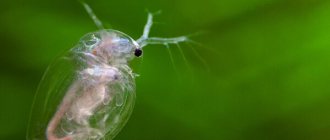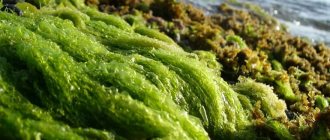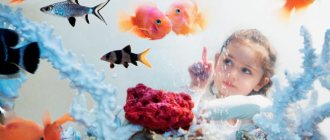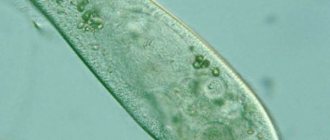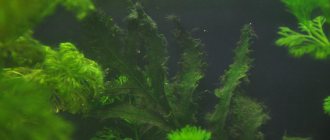Filamentous green algae is one of the big problems for aquarists. Some types of filament are practically harmless and disappear on their own after normalization of the aquatic environment. And others are capable of filling the entire reservoir in a few days and endangering the lives of its inhabitants.
What fish do you most often make sandwiches with?
- With trout 27%, 106 votes
106 votes 27%106 votes - 27% of all votes
- With salmon 24%, 94 votes
94 votes 24%
94 votes - 24% of all votes
- With sprats 20%, 77 votes
77 votes 20%
77 votes - 20% of all votes
- With salmon 14%, 55 votes
55 votes 14%
55 votes - 14% of all votes
- With herring 8%, 33 votes
33 votes 8%
33 votes - 8% of all votes
- Other 7%, 29 votes
29 votes 7%
29 votes - 7% of all votes
Total votes: 394
16.10.2019
- With trout 27%, 106 votes
106 votes 27%106 votes - 27% of all votes
- With salmon 24%, 94 votes
94 votes 24%
94 votes - 24% of all votes
- With sprats 20%, 77 votes
77 votes 20%
77 votes - 20% of all votes
- With salmon 14%, 55 votes
55 votes 14%
55 votes - 14% of all votes
- With herring 8%, 33 votes
33 votes 8%
33 votes - 8% of all votes
- Other 7%, 29 votes
29 votes 7%
29 votes - 7% of all votes
Total votes: 394
16.10.2019
×
You or from your IP have already voted.
general characteristics
Among green algae there are unicellular, multicellular and colonial representatives. They are flexible and able to survive in various conditions. Some species enter into symbiosis with fungi and form lichens.
Representatives of this department are characterized by the dominance of chlorophyll. The chromatophore of algae, like the chlorophyll of higher plants, consists of two modifications of chlorophyll - a and b. In addition, they contain carotene pigments and xanthophylls.
The cells include cell walls made of cellulose and pectin. They include starch and oil as storage substances. There are many different representatives in the Green algae department.
Cytology
Algal cells (with the exception of the amoeboid type) are covered with a cell wall or cell membrane. The wall is on the outside of the cell membrane, usually containing a structural component (for example, cellulose) and an amorphous matrix (for example, pectins or agar substances); it may also have additional layers (for example, the sporopollenin layer in chlorella). The cell membrane is either an external silicone shell (in diatoms and some other ochrophytes), or a compacted upper layer of cytoplasm (plasmalemma), in which there may be additional structures, for example, vesicles, empty or with cellulose plates (a kind of shell, theca
, in dinoflagellates). If the cell membrane is plastic, the cell may be capable of so-called metabolic movement - sliding due to a slight change in body shape.
Photosynthetic (and “masking” them) pigments are located in special organelles - chromatophores. The chromatophore has two (red, green, charophyte algae), three (euglena, dinoflagellates) or four (ochrophyte algae) membranes. It also has its own highly reduced genetic apparatus, which suggests its symbiogenesis (origin from a captured prokaryotic or, in heterokont algae, eukaryotic cell). The inner membrane protrudes inward, forming folds - thylakoids, collected in stacks - grana: monothylakoid in red and blue-green, two or more in green and charov, trithylakoid in the rest. The thylakoids, in fact, are where the pigments are located. Chromatophores in algae have different shapes (small disc-shaped, spiral-shaped, cup-shaped, star-shaped, etc.).
Many have dense formations in the chromatophore - pyrenoids. This is a place where nutrients accumulate and the zone in which the process of photosynthesis is most active.
The products of photosynthesis, which are currently surplus, are stored in the form of various reserve substances: starch, glycogen, other polysaccharides, lipids. Among other things, lipids, being lighter than water, allow planktonic diatoms with their heavy shells to stay afloat. Gas bubbles form in some algae, which also provide the algae with lifting force.
Unicellular Green algae
Most unicellular organisms are characterized by monadic and coccoid forms.
- Chlamydomonas
A single-celled, pear-shaped algae that lives in fresh waters. Chlamydomonas starch is contained in chloroplasts, which indirectly indicates the relationship of green algae with real plants. The cell is covered with a colorless shell of hemicellulose and pectin. Chlamydomonas differs from other species by the presence of two flagella of equal length.
Rice. 1. Structure of Chlamydomonas
Chlamydomonas actively reproduces in water bodies when the water blooms. It is characterized by a partially heterotrophic mode of nutrition, because consumes ready-made organic substances. It cleans water bodies of pollution.
Chlamydomonas has a special structure. It is a round cell, at the front end of which there is a protrusion - a spout with two equal flagella. Most of the organism is made up of a chromatophore with a pyrenoid - a body of protein surrounded by grain starch. It is believed that pyrenoid is involved in the fixation of carbon dioxide, as well as in the synthesis and accumulation of nutrients.
At the anterior end of the single-celled organism there are two contractile vacuoles that remove excess water and regulate turgor. The cell is characterized by the presence of a light-sensitive eye, which provides positive phototaxis. One core.
Rice. 2. Life cycle of Chlamydomonas
Chlamydomonas is able to tolerate unfavorable conditions. In this case, the flagella fall off, the walls become slimy and the cell loses its mobility. When life factors improve, flagella appear again, and the cell begins an active lifestyle.
Chlamydomonas has a simple life cycle. The haploid cell resorbs flagella, divides mitotically and forms flagella. Thus, new cellular organisms are formed. The pair of cells then combine to form a zygote (2n) with four flagella. It divides by meiosis, resulting in two cells (n).
- Chlorella
Single-celled spherical algae lacking flagella. Chlorella inhabits small standing ponds, puddles, ditches, moist soils and tree trunks. The cell is covered with a dense cellulose shell.
Rice. 3. Structure of chlorella
Most of the cell is occupied by a cup-shaped chromatophore. Like Chlamydomonas, Chlorella is characterized by the presence of a pyrenoid surrounded by starch grains. There is no stigma.
Chlorella is characterized by an asexual method of reproduction using immobile, round autospores. It is also characterized by photoautotrophic nutrition, active photosynthesis and rapid reproduction. Due to its high protein percentage, chlorella is often grown as food.
Habitats of algae (ecological niches and place in the ecological chain)
Algae are the most numerous and one of the most important photosynthetic organisms for the planet. They are found everywhere: in seas and oceans, in fresh water bodies, on moist soil and on the bark of trees.
Small free-floating algae are part of plankton and, developing in large quantities, cause “blooming” (coloring) of water. Benthic algae attach to the bottom of a reservoir or to other algae. There are algae that burrow into shells and limestone (boring); found (among the red
) and parasitic.
Large seaweeds, mainly brown ones
, often form entire underwater forests. Most algae live from the surface of the water to a depth of 20-40 m; isolated species (red and brown) with good water transparency go down to 200 m. In 1984, coralline red algae was found at a depth of 268 m, which is a record for photosynthetic organisms.
Algae often live in large quantities on the surface and in the upper layers of the soil, some of them absorb atmospheric nitrogen, others have adapted to life on the bark of trees, fences, walls of houses, and rocks. Microscopic algae cause red or yellow “coloring” of snow in high mountains and polar regions. Some algae enter into symbiotic relationships with fungi (lichens) and animals.
Algae are the main source of organic matter on Earth (more than 80% of the total biomass created per year); Almost all aquatic ecological chains begin with them. They release into the atmosphere more than half of the total amount of oxygen released by plants per year. Algae is the main food for many marine animals; some are eaten by humans. In coastal areas, algae is used for fertilizer and livestock feed.
Mobile colonial green algae
Cells of motile colonial forms are similar to Chlamydomonas. They are formed as a result of division of the zygote. The cells are held together by a mucous substance.
- Volvox
Colonial algae in the form of mobile green balls. A colony includes about 20-50 thousand cells, most of which are vegetative. Cells communicate with each other through cytoplasmic bridges.
Rice. 4. Volvox
Volvox is characterized by vegetative and sexual reproduction. As a result of vegetative growth, daughter colonies are formed, separated from the mother colony by successive longitudinal divisions. After this, they fall out into the middle of the mother’s body and are released after the destruction of the latter.
Rice. 5. Asexual reproduction of Volvox
Sexual reproduction is carried out by specialized cells without flagella. One part is transformed into female germ cells - oogonia, from which eggs (n) are formed, and the other part - into male cells - sperm (n). When they fuse, a zygote is formed - an oospore (2n). It divides first by meiosis and then by mitosis. As a result, a plate of haploid cells develops.
Classification
Algae are an extremely heterogeneous group of organisms, numbering about 100 thousand (and according to some sources up to 100 thousand species only within the diatom division) species. Based on differences in the set of pigments, chromatophore structure, features of morphology and biochemistry (composition of cell membranes, types of reserve nutrients), most domestic taxonomists distinguish 11 divisions of algae [3].
- Prokaryota ( Procaryota
) Kingdom Bacteria (
Bacteria
) Subkingdom
Negibacteria
Division Blue-green algae (
Cyanobacteria
)
- Kingdom Plants ( Plantae
) Subkingdom
Biliphyta
Division Glaucophyta algae (
Glaucophyta
)
)
)
- Division Green algae ( Chlorophyta
)
)
)
- Subkingdom Sar
or
Harosa
Superdivision (superphylum) Stramenopiles (
Stramenopiles
) or Heterokonta (
Heterokonta
) Division Ochrophyta algae (
Ochrophyta
) Class Brown algae (
Phaeophyceae
)
)
)
)
- Phylum (division) Miozoa Superclass Dinoflagellates (Dinoflagellata)
- Type (division) Cercozoa (Cercozoa) Class Chlorarachniophyceae (Chlorarachnea = Chlorarachniophyceae
)
- Division Cryptophyte algae ( Cryptophyta
)
)
- Subkingdom Eozoa Phylum Euglenozoa (Euglenozoa) Class Euglenovae (Euglenoidea = Euglenophyceae
)
Filamentous multicellular green algae
Filamentous multicellular green algae inhabit fresh water bodies and seas. They reach up to 10 cm in length. The threads consist of cells of the same size and shape.
- Ulotrix
A multicellular filamentous algae made up of a single row of cells, attached to the substrate by a long transparent cell - a rhizoid. In the cell, a horseshoe-shaped chromatophore with one or more pyrenoids is surrounded by starch grains.
Rice. 6. Structure of ulotrix
Ulotrix is characterized by asexual and sexual methods of reproduction. Each cell can differentiate into sporangium or gametangium. In the case of asexual reproduction, several pear-shaped or ovoid zoospores develop. Zoospores have an ocellus, two contractile vacuoles and four flagella. The resulting cells attach to the substrate and grow into adult algae. During asexual reproduction, the filament breaks up into cells that divide mitotically. As a result, adult organisms are formed.
Rice. 7. Reproduction of ulothrix
Ulotrix sexual reproduction occurs through isogamy. Gametes and zoospores are formed in the same organism. They are similar in structure, but different in number, size and the presence of flagella. Gametes are smaller and have two flagella, and more of them are formed. When germ cells (n) or sections of filaments merge, a zygote (2n) is formed, which goes to the bottom, loses its flagella and forms a thick shell. Then it divides by meiosis and forms zoospores (n), which emerge from the shell, attach to the substrate and germinate into an adult organism.
- Spirogyra
Multicellular filamentous algae, reaching up to 10 cm in length. Unlike ulotrix, spirogyra is not attached to the substrate, but floats freely. The filaments consist of a number of identical cylindrical cells, characterized by the presence of a cellulose cell wall, a mucous membrane, a single nucleus and a large vacuole. The formation of spores is not typical.
Rice. 8. Structure of the spirogyra cell
The main distinguishing feature of Spirogyra is a twisted chromatophore with pyrenoids. Plants reproduce sexually and asexually. During vegetative propagation, the thread disintegrates into small sections or cells. They divide by mitosis, resulting in the development of new organisms. Sexual reproduction occurs through conjugation. This process is accompanied by the threads coming together and gluing with mucus. The cells then form outgrowths that connect the two threads to each other. From the “male” organism, the contents of the cell penetrate into the “female” individual, resulting in the formation of a zygote. It becomes covered with a thick shell and enters a dormant state, after which it germinates. The zygote then divides by meiosis to form four cells, three of which die. From the remaining living cell, an adult organism is formed.
Rice. 9. Reproduction of Spirogyra
Preventive measures
To avoid a re-invasion of filamentous algae, every owner of an artificial reservoir must regularly take preventive measures:
- Systematic cleaning of the aquarium walls, substrate and decorative elements.
- Regular replacement of water in the tank. The amount of liquid to be replaced is determined depending on the capacity of the container and the requirements of the phenotypes.
- An aquarium with fish and living vegetation is installed in a lighted place, but the container should not be exposed to sunlight.
- Living vegetation is an integral part of the biobalance and should be present in every tank. In the absence or shortage of complexly organized vegetation, there is freedom for harmful guests.
- A good aeration and filtration system is installed in an artificial reservoir.
Filament in an aquarium is an annoying phenomenon that requires immediate action by the owner. It is difficult to get rid of thin greenish threads, but it is possible if you follow the rules and advice of experienced aquarists. However, it is best to prevent the appearance of filament algae by caring for the aquarium and monitoring the condition of the aquatic environment.
Lamellar multicellular green algae
Lamellar multicellular green algae live in the seas. They can reach a length of up to half a meter. They are characterized by attachment to the substrate.
- Ulva
A lamellar multicellular green algae, the thallus of which imitates a leaf structure. The structure of the ulva is more complex than that of the filamentous ulotrix, but their life cycles are similar. A haploid zoospore with flagella also grows into a filament, the cells of which divide in several directions. As a result, a leaf-like structure is formed. The cells at the base of the algae form rhizoid-like outgrowths.
Rice. 10. Reproduction of Ulva
The life cycle of Ulva is characterized by alternation of isomorphic generations. Gametophyte and sporophyte are similar in appearance. During the sexual process, gametophyte cells form anisogametes with two flagella. When gametes (n) fuse, a zygote (2n) develops. Then a filament and a leaf-shaped thallus are formed from it, like a gametophyte.
Content
- 1 General information
- 2 Cytology
- 3 Morphological organization of the thallus
- 4 Reproduction and development cycles
- 5 Ecological groups of algae
- 6 Classification
- 7 Origin, relationships and evolution
- 8 Role in nature and human life 8.1 Role in biogeocenoses
- 8.2 Food use
- 8.3 Water treatment
- 8.4 In the pharmaceutical industry
- 8.5 Chemical industry
- 8.6 Biofuels
- 8.7 In science
- 9.1 Ecohouse
Origin, relationships and evolution
Taking into account the fact that algae are an artificial group that includes organisms that are very different in systematic position (and one of the main tasks of modern taxonomy is to form systematic groups based on phylogenetic relationship, that is, precisely by origin), it makes no sense to talk about the origin and evolution of algae in general no, because some of them are prokaryotes, while others, related to eukaryotes, also have very different origins[4]. For example, green and charophyte algae form a common sister group with true, terrestrial plants ( Viridiaeplantae
), to which red algae and glaucophytes (
Glaucophyta
) are also close, together they form a separate branch
Archaeplastidae
of the phylogenetic (“evolutionary”) tree of eukaryotes.
On the other hand, dinophytes, diatoms, brown and golden algae are on another branch of eukaryotic evolution ( Chromalvelolata
), common with foraminifera, radiolarians, ciliates, coccidia, etc. Finally, a separate branch (
Excavata
) includes euglena algae and many other parasitic and free-living flagellates, among which are trypanosomes, trichomonas, diplomonas, oxymonads, etc. In total, 4 branches of the “tree of life” of eukaryotes have been identified (the fourth,
Unikonta
, contains fungi, animals, microsporidia, amoebas, choanoflagellates, etc., no algae have been identified; one small group of algae,
Chlorarachniophytes
, has an uncertain systematic position among eukaryotes), the divergence of these four lineages occurred early in the evolution of eukaryotes[5].
Literature
- Botany: Course of algology and mycology. Ed. Yu. T. Dyakova. - M.: MSU Publishing House, 2007
- Algae // Encyclopedic Dictionary of Brockhaus and Efron: in 86 volumes (82 volumes and 4 additional). - St. Petersburg, 1890-1907.
- Algae, lichens and bryophytes of the USSR. Ed. L. V. Garibova. — M.: Mysl, 1978
- Gorbunova N.P.
Algology. - M.: “Higher School”, 1991 - Life of plants in 6 volumes. Volume 3. Algae. Lichens. Ed. A. A. Fedorova. - M.: Education, 1977
- V. A. Kryzhanovsky, G. L. Bilich
. Biology. Full course. In 3 vols. Volume 2. Botany. - M.: LLC Publishing House "ONICS 21st century", 2002 - Course of lower plants. Ed. M. V. Gorlenko. - M.: “Higher School”, 1981
- Small workshop on lower plants. - M.: “Higher School”, 1976
- Parshikova T.V.
Surfactants as a factor regulating the development of algae. - K.: Phytosociocenter, 2004. - 276 p. — ISBN 966-306-083-8. - Khramtsov A.K.
A brief guide to identifying genera of freshwater algae. - Minsk, 2004. - Tullock JH
Natural reef aquarium: simplified approaches to creating living saltwater microcosmos. - Neptune City, NJ: TFH Publications, 1997. - ISBN 1-890087-01-7.
Notes
- Wasser S.P. et al.
Section 9. Brown algae - Phaeophyta // Algae: Handbook / rep. ed. S. P. Wasser. - K.: Naukova Dumka, 1989. - P. 386. - 608 p. — 6000 copies. — ISBN 5-12-000486-5. - Botany in 4 volumes. T. 1. Algae and mushrooms. Belyakova G. A., Dyakov Yu. T., Tarasov K. L. - M.: IC "Academy". — 2006.
- Universal school encyclopedia. - T.1. - M., 2004. - P. 170. - 528 p. — ISBN 5-94623-053-0.
- Patterson DJ 2000
- Keeling P., Leander B.S., Simpson A. 2009
- Tullock, 1997, p. 31.
- Plants can become oil in minutes (Russian) (inaccessible link). Compulenta. Retrieved January 16, 2014. Archived January 16, 2014.
